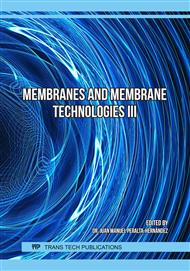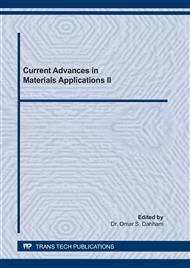[1]
N. Messikh, M.H. Samar, and L. Messikh, Neural network analysis of liquid-liquid extraction of phenol from wastewater using TBP solvent, Desalination, 208 (2007) 42–48.
DOI: 10.1016/j.desal.2006.04.073
Google Scholar
[2]
K. Snigdha, Modeling Phenol Adsorption in Water Environment using Artificial Neural Network, Int. J. Eng. Manag. Sci., 4 (2013) 303–307.
Google Scholar
[3]
Y.S. Ng, N.S. Jayakumar, and M.A. Hashim, Performance evaluation of organic emulsion liquid membrane on phenol removal, J. Hazard. Mater.,184 (2010) 255–260.
DOI: 10.1016/j.jhazmat.2010.08.030
Google Scholar
[4]
M. Kadhom, N. Albayati, H. Alalwan, and M. Al-Furaiji, Removal of dyes by agricultural waste, Sustain. Chem. Pharm.,16 (2020) 100259.
DOI: 10.1016/j.scp.2020.100259
Google Scholar
[5]
H.A. Alalwan, M.A. Kadhom, and A.H. Alminshid, Removal of heavy metals from wastewater using agricultural byproducts, J. Water Supply Res. Technol. - AQUA, 69 (2020) 99–112.
DOI: 10.2166/aqua.2020.133
Google Scholar
[6]
A. Balasubramanian and S. Venkatesan, Optimization of removal of phenol from aqueous solution by ionic liquid-based emulsion liquid membrane using response surface methodology, Clean - Soil, Air, Water, 42 (2014) 64–70.
DOI: 10.1002/clen.201200168
Google Scholar
[7]
C. Schöller, J.B. Chaudhuri, and D.L. Pyle, Emulsion liquid membrane extraction of lactic acid from aqueous solutions and fermentation broth, Biotechnol. Bioeng., 42 (1993) 50–58.
DOI: 10.1002/bit.260420108
Google Scholar
[8]
T.C.T. Chen, C.L. Liu, and H.D. Lin, Advanced artificial neural networks, Algorithms, 11(2018) 10–11.
Google Scholar
[9]
R.M. Aghav, S. Kumar, and S.N. Mukherjee, Artificial neural network modeling in competitive adsorption of phenol and resorcinol from water environment using some carbonaceous adsorbents, J. Hazard. Mater., 188 (2011) 67–77.
DOI: 10.1016/j.jhazmat.2011.01.067
Google Scholar
[10]
D. Graupe, Principle of Artificial Neural Networks. World Scientific Publishing, (2007).
Google Scholar
[11]
K.L. Du and M.N.S. Swamy, Neural networks in a softcomputing framework, Phd thesis at concordia university canada (2006 ) 1-566.
Google Scholar
[12]
H. a R. Akkar and S.A. Salman, Training Artificial Neural Network Using Back-Propagation & Particle Swarm Optimization for Image Skin Diseases, Eng. Tech. Journal, 29 (2011) 59 - 75.
Google Scholar
[13]
M.A. Ayoub and B.M. Demiral, Application of Resilient Back-Propagation Neural Networks for Generating a Universal Pressure Drop Model in Pipelines, Khartoum Univ. Eng. J., 1 (2011) 9–21.
Google Scholar
[14]
V.N.P. Dao and R. Vemuri, A performance comparison of different back propagation neural networks methods in computer network intrusion detection, Differ. Equations Dyn. Syst., 10 (2002) 1–7.
Google Scholar
[15]
K. Arya and V.P. Vishwakarma, Performance comparison on face recognition system using different variants of back-propagation algorithm with radial basis function neural networks, J. Eng. Res. Appl., 3 (2013) 1588–1595.
Google Scholar
[16]
I.A. Saleh, Conjugate Gradient Back-propagation with Modified Polack –Rebier updates for training feed forward neural network,, Iraqi J. Stat. Sci., 20 (2011) 164–173.
DOI: 10.33899/iqjoss.2011.27897
Google Scholar
[17]
M. Ghaedi, A. Daneshfar, A. Ahmadi, and M.S. Momeni, Artificial neural network-genetic algorithm based optimization for the adsorption of phenol red (PR) onto gold and titanium dioxide nanoparticles loaded on activated carbon, J. Ind. Eng. Chem., 21 (2015) 587–598.
DOI: 10.1016/j.jiec.2014.03.024
Google Scholar
[18]
N. Majeed and M. Adnan, Demulsification of Remaining Waste (Water In Oil Emulsions) After Removal Of Phenol In Emulsion Liquid Membrane Process, J. Eng., 22 (2016) 83 –102.
Google Scholar
[19]
K. Abbassian and A. Kargari, Modification of membrane formulation for stabilization of emulsion liquid membrane for extraction of phenol from aqueous solutions, J. Environ. Chem. Eng., 4 (2016) 3926–3933.
DOI: 10.1016/j.jece.2016.08.030
Google Scholar
[20]
G.K. Agrahari, N. Verma, and P.K. Bhattacharya, Removal of benzoic acid from water by reactive extraction using hollow fiber membrane contactor: Experiment and modeling, Clean - Soil, Air, Water, 42 (2014) 901–908.
DOI: 10.1002/clen.201300769
Google Scholar
[21]
S.A.M. Mohammed, Investigating the performance of ELM systems in separating organic pollutants from industrial wastewater, J. Water Process Eng., 13 (2016) 79–87.
DOI: 10.1016/j.jwpe.2016.08.001
Google Scholar
[22]
W. Völkel, W. Halwachs, and K. Schügerl, Copper extraction by means of a liquid surfactant membrane process, J. Memb. Sci., 6 (1980) 19–31.
DOI: 10.1016/s0376-7388(00)82146-8
Google Scholar
[23]
P. Stroeve and P.P.R.A.B.O.D.H. Varanasi, An experimental study on double emulsion drop breakup in uniform shear flow, J. Colloid Interface Sci., 99 (1984) 360–373.
DOI: 10.1016/0021-9797(84)90123-1
Google Scholar
[24]
J.W. Frankenfeld, R.P. Cahn, and N.N. Li, Extraction of Copper by Liquid Membranes, Sep. Sci. Technol., 16 (1981) 385–402.
Google Scholar
[25]
Q.M. Li, Q. Liu, Q.F. Zhang, X.J. Wei, and J.Z. Guo, Separation study of cadmium through an emulsion liquid membrane using triisooctylamine as mobile carrier, Talanta, 46 (1998) 927–932.
DOI: 10.1016/s0039-9140(97)00357-3
Google Scholar
[26]
H. Park and T. Chung, Removal of phenol from aqueous solution by liquid emulsion membrane, Korean J. Chem. Eng, 20 (2003) 731–735.
DOI: 10.1007/bf02706916
Google Scholar
[27]
S.A.M. Mohammed and M.S. Hameed, Extraction of 4-nitrophenol from aqueous solutions using bulk ionic liquid membranes, Int. J. Curr. Eng. Technol., 6 (2016) 542–550.
Google Scholar
[28]
Y. Park, A.H.P. Skelland, L.J. Forney, and J.H. Kim, Removal of phenol and substituted phenols by newly developed emulsion liquid membrane process, Water Res., 40 (2006) 1763–1772.
DOI: 10.1016/j.watres.2006.03.005
Google Scholar
[29]
H.R. Mortaheb, M.H. Amini, F. Sadeghian, B. Mokhtarani, and H. Daneshyar, Study on a new surfactant for removal of phenol from wastewater by emulsion liquid membrane, J. Hazard. Mater., 160 (2008) 582–588.
DOI: 10.1016/j.jhazmat.2008.03.095
Google Scholar
[30]
N. Jusoh and N. Othman, Stability of Palm Oil-based Emulsion Liquid Membrane for Succinic Acid Extraction from Aqueous Solution, J. Appl. Membr. Sci. Technol., 19 (2017) 1–17.
DOI: 10.11113/amst.v19i1.19
Google Scholar



